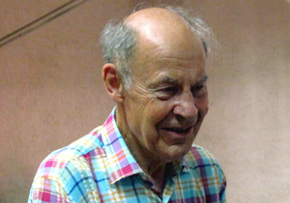Nobel Laureate in Chemistry speaks about the magic of science
Dudley Herschbach, winner of the 1986 Nobel Prize in Chemistry, uses parables to illustrate what chemistry can do.
Nobel Laureate in Chemistry speaks about the magic of science
Dudley Herschbach, winner of the 1986 Nobel Prize in Chemistry, uses parables to illustrate what chemistry can do.

Dudley Herschbach, winner of the 1986 Nobel Prize in Chemistry, uses parables to illustrate what chemistry can do
By Karina Toledo
Agência FAPESP – During a speech entitled “Glimpses of Chemical Wizardry”, U.S. scientist Dudley Herschbach – winner of the 1986 Nobel Prize in Chemistry – participated in a symposium with the world’s leading names in science, in São Carlos, São Paulo State.
Herschbach gave the inaugural class in the undergraduate chemistry course at Universidade de São Paulo’s São Carlos Institute of Chemistry (IQSC – USP), during which he presented three “molecular parables” with the intention of showing some spectacular things that science can do.
In one of the stories, entitled “A tour of life inside cells,” Herschbach talked about advanced super-resolution microscopy techniques developed by Xiaowei Zhuang, a researcher at Harvard University, which allow, for example, a scientist to study the interaction between cells and gene expression in real time.
“Science does things that truly seem impossible before they happen. Sometimes, someone in some part of the world does something magical and it changes things. It is marvelous to know that you are part of this. It is one of the rewards of science that you don’t have in the majority of professions,” Herschbach commented in an interview with Agência FAPESP.
With a degree in mathematics from Stanford University, Herschbach holds a Master’s degree in physics and chemistry, in addition to a doctorate in physical chemistry, from Harvard University, where he is a professor.
“I was the first in my family to go to university. They offered me a football scholarship, but I ended up switching to an academic scholarship because the coach banned me from going to laboratory classes so I wouldn’t be late to practice. The truth is I found science much more fascinating,” he explained.
In the 1960s, Herschbach conducted pioneering experiments with crossed molecular beams to study chemical reactions and the dynamics of the atoms of molecules in real time. For his research in this field, he received the Nobel Prize in Chemistry in 1986 along with colleagues Yuan Lee (Taiwan) and John Polanyi (Canada).
The results led to a major impact on the development of a new research field – the dynamics of reactions – and afforded a detailed understanding of how chemical reactions occur.
“When I look in the mirror and shave, I realize that winning the Nobel Prize has not changed anything about me. The only difference is that people are more interested in what I have to say. They invite me to talks and interviews. And this ends up transforming me into a type of ambassador of science,” says Herschbach.
Poetry in the classroom
Throughout the presentation, Herschbach fought against the myth that science is a harder subject, reserved for very intelligent people. “I always hear people saying that one must be very good in math to be a good researcher, but the majority of scientists use the same mathematics as a supermarket cashier. You don’t need to be good in everything, just in something – find a niche,” he affirms.
In comparing science to other human activities, Herschbach said that in no other profession can you fail countless times and still be applauded when you manage to do something right. “A musician can play almost every note right in a concert and be criticized for erring on just one,” he commented.
Herschbach explained that he often asks his students to write poems to show them that it is more important to be concerned with asking the right questions than finding the right answer.
“This, much more than resolving equations, is like doing real science. No one says that poem is right or wrong but rather how much it can open one’s eyes about something that seemed ordinary. Science is like that. If you do cutting-edge science, new things, it is very artistic. I want students to realize that they can also be wizards,” he concluded.
The symposium, presented in honor of Prof. Daniel Kleppner and entitled “Atomic physics and correlated areas”, was sponsored by the São Carlos Center for Optical and Photonic Research (Cepof), one of the Research, Innovation and Dissemination Centers (CEPID) funded by FAPESP.
The objective of the meeting was to pay homage to a U.S. physicist from the Massachusetts Institute of Technology (MIT), Daniel Kleppner, who received the title of honorary professor at IFSC-USP.
In addition to Herschbach, a friend of Kleppner's since college, four other Nobel prize winners participated in the event: Serge Haroche (2012 Nobel Laureate in Physics), David Wineland (2012 Nobel Laureate in Physics), Eric Cornell (2001 Nobel Laureate in Physics) and William Phillips (1997 Nobel Laureate in Physics).








